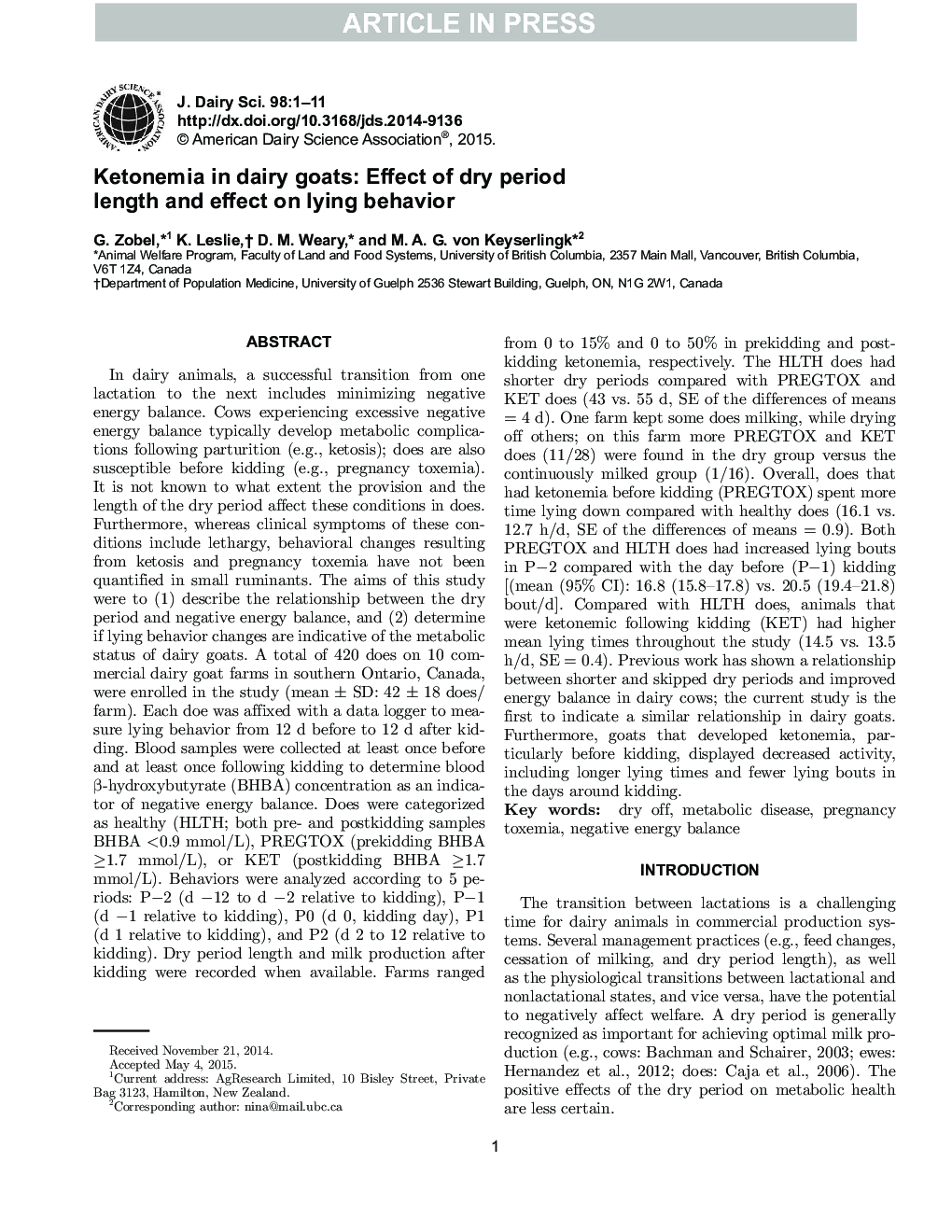| کد مقاله | کد نشریه | سال انتشار | مقاله انگلیسی | نسخه تمام متن |
|---|---|---|---|---|
| 10974316 | 1108024 | 2015 | 11 صفحه PDF | دانلود رایگان |
عنوان انگلیسی مقاله ISI
Ketonemia in dairy goats: Effect of dry period length and effect on lying behavior
ترجمه فارسی عنوان
کتونمی در بز های شیری: اثر طول دوره خشک و تاثیر آن در رفتار دروغین
دانلود مقاله + سفارش ترجمه
دانلود مقاله ISI انگلیسی
رایگان برای ایرانیان
کلمات کلیدی
خشک کردن، بیماری متابولیک، توکسین بارداری، تعادل انرژی منفی،
موضوعات مرتبط
علوم زیستی و بیوفناوری
علوم کشاورزی و بیولوژیک
علوم دامی و جانورشناسی
چکیده انگلیسی
In dairy animals, a successful transition from one lactation to the next includes minimizing negative energy balance. Cows experiencing excessive negative energy balance typically develop metabolic complications following parturition (e.g., ketosis); does are also susceptible before kidding (e.g., pregnancy toxemia). It is not known to what extent the provision and the length of the dry period affect these conditions in does. Furthermore, whereas clinical symptoms of these conditions include lethargy, behavioral changes resulting from ketosis and pregnancy toxemia have not been quantified in small ruminants. The aims of this study were to (1) describe the relationship between the dry period and negative energy balance, and (2) determine if lying behavior changes are indicative of the metabolic status of dairy goats. A total of 420 does on 10 commercial dairy goat farms in southern Ontario, Canada, were enrolled in the study (mean ± SD: 42 ± 18 does/farm). Each doe was affixed with a data logger to measure lying behavior from 12 d before to 12 d after kidding. Blood samples were collected at least once before and at least once following kidding to determine blood β-hydroxybutyrate (BHBA) concentration as an indicator of negative energy balance. Does were categorized as healthy (HLTH; both pre- and postkidding samples BHBA <0.9 mmol/L), PREGTOX (prekidding BHBA â¥1.7 mmol/L), or KET (postkidding BHBA â¥1.7 mmol/L). Behaviors were analyzed according to 5 periods: Pâ2 (d â12 to d â2 relative to kidding), Pâ1 (d â1 relative to kidding), P0 (d 0, kidding day), P1 (d 1 relative to kidding), and P2 (d 2 to 12 relative to kidding). Dry period length and milk production after kidding were recorded when available. Farms ranged from 0 to 15% and 0 to 50% in prekidding and postkidding ketonemia, respectively. The HLTH does had shorter dry periods compared with PREGTOX and KET does (43 vs. 55 d, SE of the differences of means = 4 d). One farm kept some does milking, while drying off others; on this farm more PREGTOX and KET does (11/28) were found in the dry group versus the continuously milked group (1/16). Overall, does that had ketonemia before kidding (PREGTOX) spent more time lying down compared with healthy does (16.1 vs. 12.7 h/d, SE of the differences of means = 0.9). Both PREGTOX and HLTH does had increased lying bouts in Pâ2 compared with the day before (Pâ1) kidding [(mean (95% CI): 16.8 (15.8-17.8) vs. 20.5 (19.4-21.8) bout/d]. Compared with HLTH does, animals that were ketonemic following kidding (KET) had higher mean lying times throughout the study (14.5 vs. 13.5 h/d, SE = 0.4). Previous work has shown a relationship between shorter and skipped dry periods and improved energy balance in dairy cows; the current study is the first to indicate a similar relationship in dairy goats. Furthermore, goats that developed ketonemia, particularly before kidding, displayed decreased activity, including longer lying times and fewer lying bouts in the days around kidding.
ناشر
Database: Elsevier - ScienceDirect (ساینس دایرکت)
Journal: Journal of Dairy Science - Volume 98, Issue 9, September 2015, Pages 6128-6138
Journal: Journal of Dairy Science - Volume 98, Issue 9, September 2015, Pages 6128-6138
نویسندگان
G. Zobel, K. Leslie, D.M. Weary, M.A.G. von Keyserlingk,
